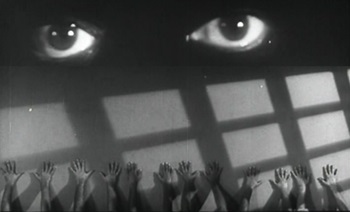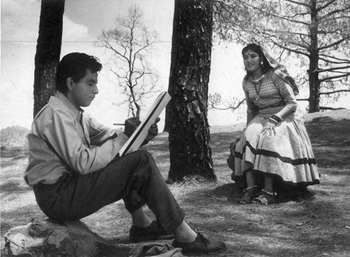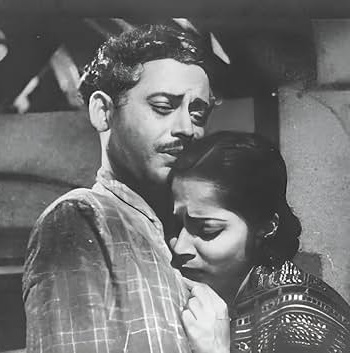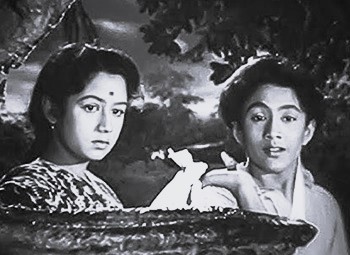Nov 03, 2025
Nov 03, 2025
The latter half of the 1950s – Part 4
More Iconic Films
Do Ankhen Bara Haath
 Do Ankhen Bara Haath is the story of an idealistic jailer who believes that even hard-core criminals can be reformed. To prove his thesis, he picks up six prisoners undergoing life imprisonment for heinous crimes. He succeeds in reforming them despite opposition from his immediate superior, sacrificing his life in the process.
Do Ankhen Bara Haath is the story of an idealistic jailer who believes that even hard-core criminals can be reformed. To prove his thesis, he picks up six prisoners undergoing life imprisonment for heinous crimes. He succeeds in reforming them despite opposition from his immediate superior, sacrificing his life in the process.
The film was inspired by an open prison experiment, carried out in 1938, by the Raja of Aundh, a princely state in the Bombay Presidency, as part of the Aundh Experiment. The story of the experiment was recounted to Shantaram by Marathi writer GD Madgulkar. The Aundh Experiment was an attempt to devolve governance to the people.
Maurice Frydman, a Polish Jew came to India in the 1930s as a refugee from Nazi persecution. He converted to Hinduism and was known as Swami Bharatananda. A supporter of the Indian independence movement, he persuaded the Raja of Aundh, to hand over his state to the residents to set an example. Prisoners were released from jail and kept in an open prison where efforts were made to reform them. The film begins with a slide about the attempt made twenty years earlier without mentioning the place or naming Frydman, who did not wish to be identified.
Shantaram in the role of the jailor, Ulhas and BM Vyas as prisoners gave sterling performances, ably supported by Sandhya as a village hawker of home-made toys. Vasant Desai and Bharat Vyas combined to give some unforgettable songs, notably, Ae malik tere bande hum, Main gaun tu chup ho ja and sainya jhoothon ka bada, all sung by Lata Mangeshkar.
The film is one of the classics of Hindi cinema. It won a Silver Bear at the 8th Berlin International Film Festival and a Golden Globe Award for best film produced outside of the United States.
Madhumati
 Bimal Roy’s Madhumati, starring Vyjayantimala and Dilip Kumar, is an evergreen classic in which everything synchronized magically. The lyrical quality of the narration and the scenic beauty of the Himalayan foothills combined to make it an artistic presentation. Salil Chowdhary’s lilting compositions of Shailendra’s lyrics like Mukesh’s Suhana safar aur ye mausam haseen, Mukesh and Lata Mangeshkar’s duet Dil tadap tadap ke keh raha hai aabhija, Lata Mangeshkar’s solos, Aaja re pardesi, ghadi ghadi mera dil dhadke and zulmi sang aankh ladi. The dances were well choreographed, especially the number, chadh gayo paapi bicchua. In the 6th Filmfare Awards in 1959, Madhumati won 9 awards, a record at the time, including Best Film, Best Director, and Best Music. Vyjayantimala became the first actress to receive dual nominations for Best Actress for Madhumati and Sadhna, winning for the latter. Salil Choudhary won his first Filmfare Award and Lata Mangeshkar was the first to win the Filmfare award for best female playback singer, instituted that year.
Bimal Roy’s Madhumati, starring Vyjayantimala and Dilip Kumar, is an evergreen classic in which everything synchronized magically. The lyrical quality of the narration and the scenic beauty of the Himalayan foothills combined to make it an artistic presentation. Salil Chowdhary’s lilting compositions of Shailendra’s lyrics like Mukesh’s Suhana safar aur ye mausam haseen, Mukesh and Lata Mangeshkar’s duet Dil tadap tadap ke keh raha hai aabhija, Lata Mangeshkar’s solos, Aaja re pardesi, ghadi ghadi mera dil dhadke and zulmi sang aankh ladi. The dances were well choreographed, especially the number, chadh gayo paapi bicchua. In the 6th Filmfare Awards in 1959, Madhumati won 9 awards, a record at the time, including Best Film, Best Director, and Best Music. Vyjayantimala became the first actress to receive dual nominations for Best Actress for Madhumati and Sadhna, winning for the latter. Salil Choudhary won his first Filmfare Award and Lata Mangeshkar was the first to win the Filmfare award for best female playback singer, instituted that year.
Sujata
Bimal Roy’s Sujata explored the situation of caste in India. Sunil Dutt was cast opposite Nutan, with Shashikala and Sulochana in important roles. SD Burman’s music and the lyrics by Majrooh Sultanpuri greatly complemented the narration. Nutan lived the role of the unfortunate untouchable, and Sunil Dutt gave an understated performance. In an endearing sequence, Sunil Dutt serenades a coyly pleased Nutan over the telephone, singing Jalte hain jiske liye in the persuasive voice of Talat Mahmood. Ebullient Shashikala is a brilliant foil for the heroine, singing Asha Bhonsle’s Bachpan ke din and Tum jiyo hazaron saal with gusto. SD Burman sang in a Hindi film more than a decade after he sang Umeed bhara panchhi in the Bombay Talkies film Eight Days in 1947. Sun mere bandhu re, the heartfelt call to the friend, sensitively accompanies the sequence showing the heroine falling in love. Asha Bhonsle’s Kali ghata chhayi and Geeta Dutt’s soporific, Nanhi kali sone chali complete one of SD Burman’s best scores. Sujata was ranked seventh among 1959's highest-grossing films. It also won Filmfare Awards in 1960 for Best Movie, Best Director, and Best Story. Nutan won her second Filmfare Award for Best Actress for her performance in the film.
Kaagaz Ke Phool
 Kaagaz Ke Phool, (1959), directed by Guru Dutt, who also played the lead along with Waheeda Rehman, was the first Indian film in CinemaScope. The film tells the story of a film director, whose marriage is on the rocks and whose daughter is kept away from him. He meets a woman whom he turns her into a star. The publicity surrounding the liaison of these two lonely people creates problems for the director’s daughter. Moved by the girl’s plight, the new star abandons her career. The film traces the personal and professional downfall of the director, bereft of family and love, until his death as a lonely and forgotten man. The story had similarities with Guru Dutt’s personal life, his troubled marriage with Geeta Dutt, and his relationship with Waheeda Rehman.
Kaagaz Ke Phool, (1959), directed by Guru Dutt, who also played the lead along with Waheeda Rehman, was the first Indian film in CinemaScope. The film tells the story of a film director, whose marriage is on the rocks and whose daughter is kept away from him. He meets a woman whom he turns her into a star. The publicity surrounding the liaison of these two lonely people creates problems for the director’s daughter. Moved by the girl’s plight, the new star abandons her career. The film traces the personal and professional downfall of the director, bereft of family and love, until his death as a lonely and forgotten man. The story had similarities with Guru Dutt’s personal life, his troubled marriage with Geeta Dutt, and his relationship with Waheeda Rehman.
The film bombed at the box office. Perhaps the masses could not identify with the characters or follow the intricate style of narration. Its cinematography was considered a technical revolution in Indian films. The film was later resurrected as a cult classic in the 1980s. Kaagaz ke Phool is now a part of syllabi in many film schools. It is the finest self-reflexive film ever made in India. It was the last film credited with direction by Guru Dutt, although his hand is discernible in all subsequent films made by Guru Dutt Films.
The film's music was composed by SD Burman and the lyrics were written by Kaifi Azmi except for one song by Shailendra. Mohammed Rafi’s poignant rendering of Dekhi zamane ki yari and Ud ja ud ja pyase bhanwre aligns with the theme. Waqt ne kiya kya haseen sitam is an excellent instance of a combination of acting, music, lyrics, photography, and lighting to explain the unexpressed feelings of the leading pair. Cinematographer VK Murthy won the Filmfare Best Cinematographer Award for his work in the film.
Other Movies
Ashok Kumar’s other films in this period were Howrah Bridge, Ragini, Savera, and Sitaron se Aage. Shakti Samanta’s Howrah Bridge was his first production under Shree Shakti films. Shakti Samanta first met Ashok Kumar in 1948 soon after he joined Bombay Talkies as an assistant director to Phani Majumdar. Shanti Samanta took up direction instead of acting on Ashok Kumar’s advice. When Shakti got a chance to direct Inspector (1956), he cast Ashok Kumar in the lead. The film proved a hit, and Ashok Kumar remained the first to be cast by the director in all his movies. For Howrah Bridge, Shakti could not afford Ashok Kumar and Madhubala. When Ashok Kumar heard the story, he signed the contract for one rupee, saying, ‘I will collect my payment when the film is released.’ He even persuaded Madhubala to agree to act in Howrah Bridge on the same terms. Howrah Bridge was a major commercial success specially noted for its songs Mera Naam Chin Chin Chu and Aaiye Meherbaan sung by Asha Bhonsle and Eent Ki Dukki, Paan Ka Ikka sung by Mohammed Rafi.
Ragini, produced by Ashok Kumar, is best remembered for its songs tuned by OP Nayyar, Asha Bhonsle’s Chhota sa balama, and the hilarious Kishore Kumar and Asha Bhonsle duet Main Bangali Chhokra. Mohammed Rafi sang Man mora banwra for Kishore Kumar. Satyen Bose’s Savera and Sitaron se Aage were moderately successful. In Savera, Chhupa Chhupi O Chhupi Agad Bagad Jai Re< tuned by Sailesh Mukherjee was popular and Sitaron se aage, with music by SD Burman, had good tunes like Roye jiya, Chanda ki chandni and Zara ruk ja pyare.
 V Shantaram’s Toofan Aur Diya is about the struggles of an orphaned brother and sister, played by Satish Vyas and Nanda. The film leaves a message of hope and belief that any adversity can be overcome with determination and faith in God. The lyrics by Bharat Vyas and music by Vasant Desai, particularly the title song nirbal ki ladai balwaan ki, sung soulfully by Manna Dey, enhance the message.
V Shantaram’s Toofan Aur Diya is about the struggles of an orphaned brother and sister, played by Satish Vyas and Nanda. The film leaves a message of hope and belief that any adversity can be overcome with determination and faith in God. The lyrics by Bharat Vyas and music by Vasant Desai, particularly the title song nirbal ki ladai balwaan ki, sung soulfully by Manna Dey, enhance the message.
After the success of Pyaasa, Guru Dutt began to accept acting assignments outside his own production company. One such film was GP Sippy’s 12 O’Clock, directed by Pramod Chakravorty. Guru Dutt and Waheeda Rehman made an attractive and lovable pair. OP Nayyar provided some memorable tunes notably, Mohammed Rafi and Geeta Dutt’s duet, Tum jo huwe mere humsafar, Mohammed Rafi’s solo Main kho gaya and Geeta Dutt’s solo, Kaisa Jadoo balam Tu ne dala.
Hrishikesh Mukherjee’s Musafir narrates three stories linked by a house. The film stars Suchitra Sen, Shekhar, Kishore Kumar, Nirupa Roy, Dilip Kumar, and Usha Kiran. Music director Salil Chowdhary composed some good tunes including Kishore Kumar’s hit song, Munna bada pyara. Dilip Kumar sang in the film for the first time with Laagi nahi chhoote rama, a duet with Lata Mangeshkar. The film was adjudged the third-best feature film at the National Film Awards in 1957.
Madhubala looked her most charming and vivacious in Sohrab Modi’s Raj Hath (1956) and character actor Om Prakash’s comedy Gateway of India (1957). In Raj Hath, Mohammed Rafi’s solo Aye bahar banke and Mukesh Lata Mangeshkar's duet Ye vada karo chand ke samne are memorable songs. Mere sapnon mein aana re showcased Madhubala’s beauty and charm. For Gateway of India, Madan Mohan composed some memorable songs, especially Mohammed Rafi and Lata Mangeshkar's duet, Do ghadi wo jo paas aa baithe, and Lata Mangeshkar’s solo Sapno me sajan se do baaten.
In 1958, Madhubala, got four hits in a row, Kala Pani, Chalti Ka Naam Gaadi Howrah Bridge, and Phagun, a musical romance directed by Bibhuti Mitra. The success of Phagun was entirely due to songs composed by OP Nayyar. Ek Pardesi mera dil le gaya and Piya piya na lage mora jiya were instant hits while Mohammed Rafi’s solo main soya ankhiyan meeche remains a connoisseur’s item. Madhubala did well in Ek Saal (1957), in which she was again paired with Ashok Kumar, Shakti Samanta’s Insan Jaag Utha (1959), a social drama on emerging India, Kal Hamara Hai, and Do Ustad (1959). Talat Mahmood’s Sab kuchh luta ke hosh mein from Ek Saal remains in people’s memories. For Insan Jaag Utha, Asha Bhonsle and Geeta Dutt sang Janu Janu re, one of the best female duets ever. Asha Bhonsle and Mohammed Rafi’s duet, Chand sa mukhda kyun sharmaya is another popular song from the film.
One of the notable films of the period was Adalat, produced by Kwatra Films, written and directed by Kalidas. The film starred Nargis, Pradeep Kumar and Pran. The film deals with the travails of a woman separated from her husband and ill-treated by his family. In the title role, Nargis gave one of the best performances of her career. Pran, as her tormentor, was at his villainous best. Madan Mohan’s music turned Rajinder Krishna’s lyrics into some of the best ghazals in Hindi films in the voice of Lata Mangeshkar. Jana tha humse door, Unko ye shikayat hai, Yun hasraton ke daag are unforgettable ghazals and the songs Ja ja re Ja balama, zameen se hamen aasmaan par, and the bhangra number dupatta mera malmalka were hits. However, the film did not become a hit.
Incidentally, its producer Shardul Singh Kwatra, was a multifaceted artiste, film producer, director music composer, and actor. He played a small role in Adalat. He produced mostly Punjabi films. Some notable Hindi films produced by Kwatra films are Jalte Deep (1950), Goonj, and Bewafa (1952).
SN Tripathi was another less-known music director, who was multi-faceted. He was a composer, writer, actor, producer, and director of films. The songs Janam janam ke phere and Zara samne to aao chhaliye from Janam Janam Ke Phere (1957), and Aa laut ke aajaa mere meet, Jhanana jhan Baje payaliya and Baat chalata Nayi chunari rang daali from Rani Rupmati (1957) were major hits.
Hamein to loot liya mil ke husna walon ne a qawwali from Al Hilal (1958) sung by Ismail Azad Qawwal took the country by storm.
Continued to Next Page
30-Nov-2024
More by : Ramarao Annavarapu

|
Sir, your this write up is superb as always. The trivia about Kagaz Ke Phool and Howrah Bridge were new and very informative. I wish you could give all your articles, the shape of a book in one or two volumes. They will be highly welcome by the cine buffs. Regards, K.L. Pandey |

|
As always, a beautiful piece, Sir. I do remember watching Kagaz Ke Phool. Like Sahib Bibi aur Gulam, this movie had a dark, tragic theme. Both films were art films of the day, carrying a deep inner meaning. Guru Dutt and Waheeda were my favourites. They seemed to be both well seasoned artistes with not the slightest trace of immaturity. Sadly, the golden age of cinema is past. They dont make movies like that anymore. Keep up the good work! |

|
Dear Mr. Ramarao, I am an ex Railwayman having retired as GM SOUTHERN RAILWAY. I am an avid reader of your blogs which I receive as forwarded by Mr. Bisht. Being an enthusiastic fan of old Hindi movies and songs, I really love your posts. You write with a lot of feeling and passion. Please do continue to write......it is great fun reading you. |

|
Wow...what a wealth of information! Wondeful! |